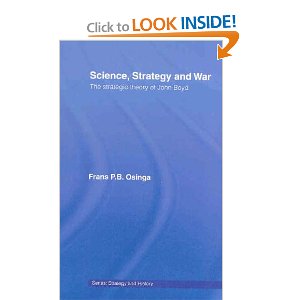
Frans P.B. Osinga
5.0 out of 5 stars “Hell of an Engineer”
October 24, 2010
By Retired Reader (New Mexico) – See all my reviews
Phi Beta Iota: This is the long review provided directly to Phi Beta Iota. A shorter review can be read at the Amazon Page.
I have just completed a first read of “Boyd”, by Robert Coram and have concluded that I a made a big mistake reading Osinga’s book first. Osinga explains what Boyd did; Coram describes how he did it. If you read Coram’s book first, Osinga’s book will be much easier to tackle. Both are quite good, but Coram gives a much better sense of the context in which Boyd did his work and a better understanding of who John Boyd was and what he represented. Robert D. Steele has an excellent review of Coram’s book that I recommend. I purchased both books at the same time, but read them in the wrong order.
I was not surprised to find from the Coram book that Boyd attracted a select group of like minded individuals who put integrity ahead of the go along to get along mehtod of moving forward. We could certainly use a similar group at the Pentagon of 2010.”
This book has the rather ambitious goal of “better understanding the strategic thought developed” by Colonel John Boyd (USAF ret.). For the most part it succeeds in doing this. Since Boyd choose not consolidate his thoughts into one or more books, Osinga was forced to develop his information from Boyd’s slides used to brief his ideas and from Boyd’s notes. So what does this book tell the reader about the “strategic thought” of Colonel Boyd?
Although Osinga does not address it, John Boyd appears to have had what can only be called the mind of an engineer. The application of scientific principals to practical ends seemed to come naturally to him. He actually received a degree in industrial engineering from Georgia Tech in 1962, but this appeared to have primarily credentialed his existing engineering talent.
Boyd was an experienced and successful fighter pilot from the Korean War and his initial engineering efforts had to do with designing an air superiority fighter. To this end Boyd developed a simple, but revolutionary concept for fighter design namely the relationship of Energy to Maneuverability or EM concept. Once Boyd developed the EM Concept it was obvious, but he was surprised to discover that no one had thought of it before. Application of this concept led directly to the development of the F-15 fighter and to the most cost effective and versatile fighter produced in the last quarter of the 20th Century, the F-16.
Boyd is best known for his brilliant and original concept of command and control (C2) processes, the so-called Observation, Orientation, Decision, Action (OODA) loop. Like the EM concept once somebody thinks of it the OODA loop is obvious, but only after Boyd developed it. The OODA loop describes what are quite complex C2 processes. It was developed directly from Boyd’s analysis of physics specifically quantum mechanics, the Second Law of Thermodynamics, and Quantum Mechanics (especially Heisenberg’s Law of Indeterminacy) and their relationship to conflict and war. Because Boyd developed the OODA loop from these broad scientific concepts, it is applicable to tactical, operational, and strategic situations.
With the OODA loop Boyd had developed the precursor of what was later described as “Network Centric Warfare” both in its limited meaning as a Command, Control, Computer, Communications, Intelligence, Reconnaissance, and Surveillance (C4ISR) system and its broader strategic implications as a strategic concept. Boyd emphasized the importance of communications as the foundation of the loop and information management as essential to the Orientation portion of the loop. The OODA strategic applications were related to creating greater flexibility by moving decision making down to the lowest level while creating situational awareness on the highest level. On a grand strategy level Boyd noted the goal of any conflict was to undermine the morale and will of an opponent by “getting inside the opponents OODA loop and creating confusion and uncertainty. In this respect in successfully transformed the teachings of Chinese strategic thinker Sun Tzu into modern applications.
This book provides considerably more about Boyd’s thinking and more importantly his approach to problem solving. The few random notes in this review are meant to give an idea of the breadth and depth of this brilliant engineer and military analyst as revealed by this outstanding study.
Afterthought: John Boyd, like many people to whom brilliance comes naturally, was probably not a good teacher and so did not develop a following of disciples who could have carried on his work after his death. Also he unfortunately did not consolidate his thoughts into a book or books, but only wrote presentation papers. This is a shame because his strategic grasp and understanding of engineering principles are desperately needed today in an increasingly dysfunctional national security establishment.

Phi Beta Iota: The single best book on Boyd and his contribution remains Boyd–The Fighter Pilot Who Changed the Art of War.
Other books on Boyd have become available, Robert Coram's deeply researched and brilliantly articulated biography remains in a class by itself.



